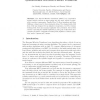Free Online Productivity Tools
i2Speak
i2Symbol
i2OCR
iTex2Img
iWeb2Print
iWeb2Shot
i2Type
iPdf2Split
iPdf2Merge
i2Bopomofo
i2Arabic
i2Style
i2Image
i2PDF
iLatex2Rtf
Sci2ools
DATESO
2007
2007
Syllable-Based Burrows-Wheeler Transform
The Burrows-Wheeler Transform (BWT) is a compression method which reorders an input string into the form, which is preferable to another compression. Usually Move-To-Front transform and then Huffman coding is used to the permutated string. The original method [3] from 1994 was designed for an alphabet compression. In 2001, versions working with word and n-grams alphabet were presented. The newest version copes with the syllable alphabet [7]. The goal of this article is to compare the BWT compression working with alphabet of letters, syllables, words, 3-grams and 5-grams.
| Added | 29 Oct 2010 |
| Updated | 29 Oct 2010 |
| Type | Conference |
| Year | 2007 |
| Where | DATESO |
| Authors | Jan Lansky, Katsiaryna Chernik, Zuzana Vlckova |
Comments (0)

